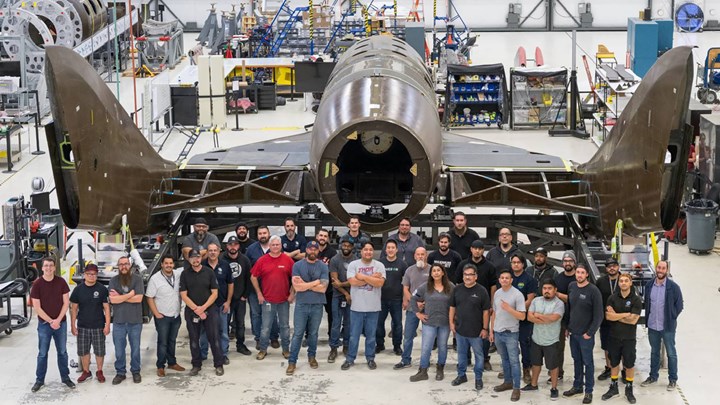Spaceship Co. attaches feather system to next SpaceShipTwo
Virgin Galactic’s sister company has completed a major milestone in the manufacture of the composites-intensive SpaceShipTwo, which will carry tourists on short-duration space flights.

Spaceship Co. employees stand before the second SpaceShipTwo the company is building for Virgin Galactic. The company is celebrating a milestone in the the attachment of the spacecraft’s feather system. See video below for more images. Source | Virgin Galactic.
Space tourism company Virgin Galactic (Mojave, Calif., U.S.) reported on Dec. 15 that sister company The Spaceship Co. (Mojave) has taken a key step on the path to completing the second spaceship in Virgin Galactic’s fleet. The team has attached the structure of SpaceShipTwo’s “feather system” to the wing of the new vehicle, in what is a union of two major components of the airframe. This latest milestone is the final step prior to resting the vehicle’s weight on its wheels. SpaceShipTwo is fabricated with carbon fiber composite materials.
The feather is unique to the SpaceShipTwo flight system, giving the vehicle the capability to change its shape in space to ensure a safe, flight-proven, aerodynamically controlled re-entry into the Earth’s atmosphere on a repeated basis.
SpaceShipTwo is designed to carry passengers to low-Earth orbit on short-duration trips into weightless space. SpaceShipTwo is initially carried by MotherShipTwo and at a designated altitude SpaceShipTwo detaches from MotherShipTwo and is propelled to low-Earth orbit via rocket. Once the rocket motor burn is completed and the passengers have experienced low-Earth orbit, the pilots extend the feather upward on SpaceShipTwo, which results in the aft wing and tail booms rotating upward to approximately a 60-degree vertical orientation. The feather is what provides stability during re-entry to the Earth’s atmosphere. During this phase of spaceflight the vehicle acts like a shuttlecock or birdie, orienting the ship to the proper re-entry attitude. This orientation creates high drag, which slows SpaceShipTwo quickly while high in the atmosphere. This also allows the thermal loads generated from re-entering the atmosphere to spread evenly over the surface area of the vehicle rather than concentrating on a few small points.
Once SpaceShipTwo has re-entered the atmosphere, the feather is rotated back to its original position, which allows the pilots to glide the spaceship back to Earth for a runway landing at Spaceport America, N.M., U.S.
The Virgin Galactic fleet is being built by The Spaceship Co. The build process is based on a modular plan and each part of the spaceship is fabricated separately before final assembly. Virgin Galactic’s first spaceship, VSS Unity, also built by The Spaceship Co., is progressing through its flight test program, with the next two vehicles in production.
George Whitesides, CEO of Virgin Galactic, says, “Completing this milestone is an important moment in the build of our next spaceship and signals that our fleet is starting to take shape. We have specifically designed our space system with a fundamental focus on safety, customer experience and reusability and the feather mechanism is key to enabling how we do this.”
Related Content
-
Composites manufacturing for general aviation aircraft
General aviation, certified and experimental, has increasingly embraced composites over the decades, a path further driven by leveraged innovation in materials and processes and the evolving AAM market.
-
Manufacturing the MFFD thermoplastic composite fuselage
Demonstrator’s upper, lower shells and assembly prove materials and new processes for lighter, cheaper and more sustainable high-rate future aircraft.
-
ASCEND program update: Designing next-gen, high-rate auto and aerospace composites
GKN Aerospace, McLaren Automotive and U.K.-based partners share goals and progress aiming at high-rate, Industry 4.0-enabled, sustainable materials and processes.
















